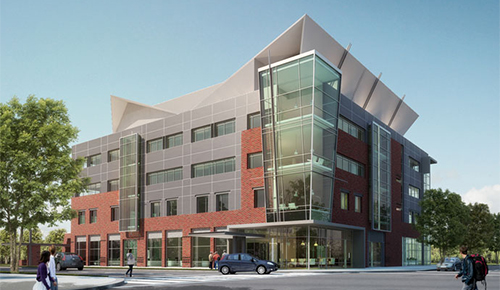Located in the western end of Ontario’s Golden Horseshoe, the City of Hamilton has emerged as one of the premier destinations in Canada and all of North America for new investment — all within the course of a decade.
A city once largely influenced by the steel and textile industries is today one of the most economically diverse cities in Ontario. Hamilton is a rising hot spot for the life sciences, advanced manufacturing, goods movement, creative industries, and next generation technologies sectors.
It’s also home to McMaster University and McMaster Innovation Park. And therein lies a story of innovation and partnership in economic development.
Unprecedented Momentum
Strategic location and tremendous infrastructure factor strongly into Hamilton’s success.
The city is situated about halfway between Toronto and the U.S. border near the southwest corner of Lake Ontario. It has long been considered a transportation hub with the Port of Hamilton (the busiest among the Canadian Great Lakes ports), the John C. Munro Hamilton International Airport (Canada’s largest courier and cargo airport), and proximity to a network of highways and rail. McMaster is one of Canada’s top three most research-intensive universities, and Mohawk College is the largest trainer for apprenticeships in Ontario. In addition, Hamilton Health Sciences, a conglomerate of six unique hospitals and a cancer center, caters to health care needs from preconception through to aging adults.
 Westinghouse President Herbert Rogge, in a 1954 speech to the Hamilton Chamber of Commerce, first coined the term “Golden Horseshoe” to describe the land wrapping around Lake Ontario’s westernmost corner.
Westinghouse President Herbert Rogge, in a 1954 speech to the Hamilton Chamber of Commerce, first coined the term “Golden Horseshoe” to describe the land wrapping around Lake Ontario’s westernmost corner.While these factors have been long in play for Hamilton, the last five years have been “special times” for the city, says Norm Schleehahn, manager of business development for the Hamilton Economic Development Office. He has observed more activity from 2008 to 2012 than at any other time during his 23 years of service with the city. City records show more than $4.8 billion in the total value of building permits issued during this period, with 2012 in particular being a record-breaking year.
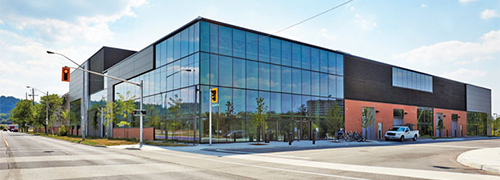
 McMaster Innovation Park continues to pursue its build-out, including a new Emerging Technology Centre (rendering below) and the $26-million McMaster Automotive Resource complex (left), which opened in May 2013.
McMaster Innovation Park continues to pursue its build-out, including a new Emerging Technology Centre (rendering below) and the $26-million McMaster Automotive Resource complex (left), which opened in May 2013.
“Hamilton is firing on all cylinders,” says Schleehahn, noting how new investments can be seen across the downtown district, in several industrial parks, along main corridors and throughout the city
A Landmark Moment
In December 2003, the announcement came that would end up impacting a community in unimaginable ways. One of Hamilton’s long-time industrial giants, Camco, Inc., was to close down a facility with a 90-year history in the city due to industry changes and global competitive pressures. The question of what to do with the 37 acres of land owned by the company became paramount.
At the same time, McMaster University, one of Hamilton’s top five employers, was also in a conundrum, explains Nick Markettos, assistant vice president for research partnerships. While the university was excelling in performing cutting-edge research, it lacked a research park for university researchers to meaningfully connect with industry and government and explore commercialization opportunities. To help accomplish this goal, the university considered developing a biotech incubation center as a starting place, and began searching for property close to campus.
Then, suddenly, the nearby Camco site became available, and what began as plans for a biotech center evolved quickly into plans for a much more all-encompassing project to transform brownfields and warehouses into a premier research park. The university closed on the property in January 2005, purchasing it for $13 million with its own internal funds.
While negotiations with Camco were under way, university officials were engaging in some equally important and fruitful discussions with the City of Hamilton, the Province of Ontario and the Government of Canada, explains Markettos.
McMaster Innovation Park has fast emerged as a regional innovation center where entrepreneurs and those wishing to connect with entrepreneurs want to be.
In 2005 the City of Hamilton provided $5 million toward the development of a biotech incubator. Soon thereafter, the Province of Ontario contributed $10 million toward the project for infrastructure, roads, and demolition. And the Government of Canada, pursuant to discussions that already had been under way with the city before the Camco opportunity, announced it would relocate a major federal laboratory to the park. Also in 2005, GM and the university entered into an agreement to conduct joint research at the park.
A Focal Point for Innovation
With the help of Diamond and Schmitt Architects, a campus master plan for the park was developed and unveiled in January 2006. The aim was to provide a place for co-locating, connecting, and commercializing — while staying connected to McMaster University and the many assets in the City of Hamilton, such as its nearby thriving downtown district. Plans call for over 1.7 million sq. ft. (157,930 sq. m.) of office, research, and amenity space for 3,000 park occupants.
McMaster Innovation Park is managed through a trustee corporation with its own board of directors and a management team of four full-time professionals. According to Mark Stewart, manager of marketing and leasing, the goal is to provide a high-quality work and play environment.
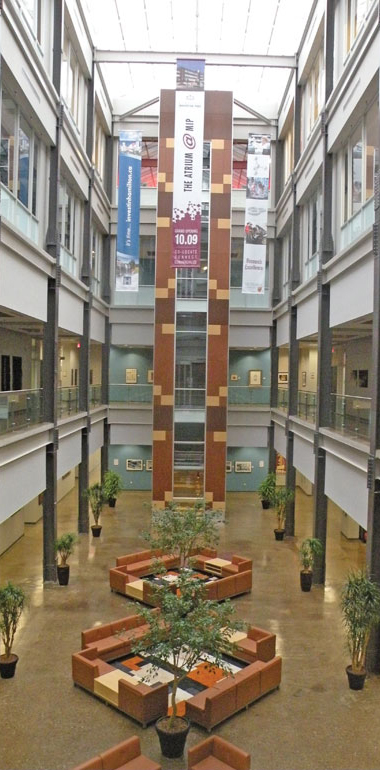
![]() It’s a lot of fun
It’s a lot of fun
being here. ![]()
— Tim Richard, Weever Apps, on the “amazing” facility at McMaster Innovation Park known as The Atrium, which has proved popular among Hamilton’s growing community of entrepreneurs.
“You can come and get a small office with a high-end boardroom and be able to walk in the park for lunch,” he says. In addition to landscape and buildings focused on sustainability, best practices for creating a pedestrian- and bike-friendly environment are being employed, and attention is being given toward creating a place that encourages interaction and creativity.
Greater than any of the physical amenities is the access tenants are provided to top researchers and business leaders affiliated with the university, and a variety of service providers. This is most visible at the Atrium, a building refurbished from its Camco days. Opened in October 2009, the facility is home to more than 35 entrepreneurs (from start-up to second-stage) and service firms (e.g. accounting, legal, marketing) interested in helping entrepreneurs grow.
In November 2010, the relocated federal lab known as the CANMET-MTL Research Centre became the second building to open. The center has become a main anchor for the park for both university- and industry-related interests. It is located in a 167,000-sq.-ft. (15,514-sq.-m.) LEED-Platinum building that was built to suit, and it is dedicated to advanced metals and materials fabrication, processing and evaluation. The center’s design required some creative engineering, points out Stewart, as an operating mill and electron microscopes are at work in the same facility.
The third building to officially open in the park was the McMaster Automotive Resource Centre (MARC) in May 2013. This $26-million facility will allow for both private and public sectors to work together to develop, design, and test hybrid technology. It is at MARC where researchers from the university and GM will be conducting joint research in the area of corrosion engineering.
Plans are also under way for a fourth building — the 80,000-sq.-ft. (7,432-sq.-m.) Emerging Technology Centre. The center will create a space where those engaged in bioscience, nanoscience, advanced materials, robotics, health care, renewable energies, the humanities and social sciences and other disciplines will have the opportunity to connect regularly. Markettos says the building represents a departure from the thinking that each building needs to represent a particular discipline, and was informed by some best practices in the United States.
“We are finding,” he says, “that innovation often occurs at the intersection of different industries.”
An Entrepreneur’s Story
In 2011, Tim Richard joined up with three partners to create Weever Apps, a company that provides a cloud-based, do-it-yourself online tool which enables marketers, without programming experience, to design and launch mobile apps quickly and affordably. The company was “birthed” in the Innovation Factory within McMaster Innovation Park.
Richard credits his company’s success to being in the right place at the right time. The right place was the Innovation Factory and Atrium settings, which provided him and his colleagues the opportunity to meet other entrepreneurs, resource providers and potential clients, while receiving some needed management and technical assistance.
The right time was their arriving within a month of the launch of the Lion’s Lair — a high-profile, widely publicized “pitch” event for entrepreneurs — by the Hamilton Chamber of Commerce and Innovation Factory. Winning the “people’s choice award” at that event, says Richard, is what turned his company from an everyday start-up to an overnight success.
Since then, Weever Apps has served some of the largest organizations in the world. Within the course of two years, the company has grown from four to 10 employees. While it outgrew its incubation space in the Innovation Factory, Richard and his partners chose to stay and lease space in the Atrium.
“It’s a lot of fun being here,” says Richard. He describes the Atrium as an amazing facility that has fostered a sense of community and excitement among those in the building. Richard also shares a serendipitous connection with the building — it happens to be the place where his mother worked to help build washing machines for Westinghouse (a facility bought by Camco in 1977) some 50 years ago.
Another Landmark Moment
In 2008, a couple years after the City of Hamilton invested $5 million into the development of McMaster Innovation Park, city leaders adopted a vision to be more aggressive in other efforts to increase the city’s non-residential tax base. The idea, says Schleehahn, was to increase that tax base with what would become an annual “injection” of $1.5 million for city operations that support economic development. Eight to 10 positions were created in critical function areas such as marketing, business development and planning.
The city also significantly expanded its focus on existing enterprise by launching a corporate calling program. According to Schleehahn, the Hamilton Calling program has enabled company decision makers to develop a trusted relationship with a person at City Hall to address their concerns, from how to recycle to how to expand their business.
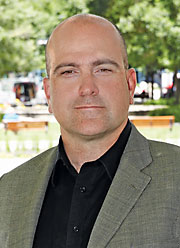
![]() We get to know each
We get to know each
other at a very high level. ![]()
— Norm Schleehahn, manager of business development, Hamilton Economic Development Office, on his team’s Hamilton Calling program, which has enabled more than 1,000 face-to-face conversations with area business leaders in the past five years.
“We get to know each other at a very high level,” he says, explaining that his team will do face-to-face visits with each company. More than 1,000 companies have been called on in the past five years, he says. A review of some recent expansions signals that these efforts are paying off. For example, in 2011, courier giant Purolator invested $9 million in its existing Hamilton airport cargo center, and Richardson International invested over $5.5 million to expand its port facility.
The city’s investment also appears to be paying off on the attraction side with some big wins in recent years. In 2010, Canada Bread announced it would construct a $100-million, 385,000-sq.-ft. (35,767-sq.-m.) bakery, the largest commercial bakery in Canada, in Red Hill Business Park.
A highway infrastructure project completed in 2007 and connecting this particular industrial park in the mountain area to the Queen Elisabeth Way (QEW) made it a more viable location for business, explains Schleehahn. Now fully operational, Canada Bread employs 350 workers. The project served as a catalyst for other major investment in the park. In 2011, Maple Leaf Foods announced it would build a $395-million state-of-the-art meat processing plant in the park and create 670 jobs. And in 2012, Navistar announced it will build a 250,000-sq.-ft. (23,225-sq.-m.) distribution center across the road from Maple Leaf.
Hamilton is becoming increasingly recognized by others for these and other economic development achievements. The city was named as the best place to invest in Ontario by the Real Estate Investment Network (REIN) of Calgary in 2011 and 2012. In 2012, the Conference Board of Canada ranked its economy as the fastest growing among cities in Ontario. Hamilton was named as a top Canadian metro area for corporate investment by Site Selection in 2012 and 2013. Also in 2013, Hamilton’s economic development office was named an Accredited Economic Development Organization by the International Economic Development Council in recognition of its professional excellence.
The Road Ahead
While it’s still early for McMaster Innovation Park, and much work is yet to be done to fully develop the site, the partners have reason to feel a sense of accomplishment for what has been achieved thus far. A recent study by Focus Business Consulting suggests that tenants at the park have already generated nearly $34.5 million for Ontario, and there are 1,340 full-time jobs attributable to the park. Markettos says the university has more than recouped its initial $10-million investment.
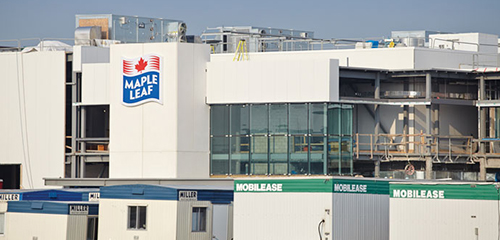 Maple Leaf Foods is building a $395-million plant in Red Hill Business Park that will create 670 jobs.
Maple Leaf Foods is building a $395-million plant in Red Hill Business Park that will create 670 jobs.City officials are already beginning to anticipate development beyond the park. The city created the West Hamilton Innovation District for the west end of Hamilton where the park is located. The district provides development guidelines to encourage knowledge-intensive industries on properties adjacent to the park. “We welcome this,” says Markettos, who looks forward to a continued partnership with the city in building a knowledge-based economy in Hamilton.
This Investment Profile was prepared under the auspices of the City of Hamilton Economic Development Office and McMaster Innovation Park. For more information, visit www.investinhamilton.ca and www.mcmasterinnovationpark.ca.
